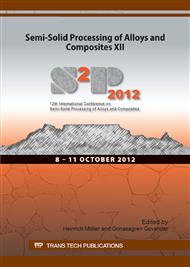p.317
p.323
p.329
p.335
p.341
p.347
p.353
p.359
p.365
Studies on Rheocasting Using Cooling Slope
Abstract:
In the present work, a cooling channel is employed to produce semi-solid A356 alloy slurry. To understand the transport process involved, a 3D non-isothermal, multiphase volume averaging model has been developed for simulation of the semi-solid slurry generation process in the cooling channel. For simulation purpose, the three phases considered are the parent melt, the nearly spherical grains and air as separated but highly coupled interpenetrating continua. The conservation equations of mass, momentum, energy and species have been solved for each phase and the thermal and mechanical interactions (drag force) among the phases have been considered using appropriate model. The superheated liquid alloy is poured at the top of the cooling slope/channel, where specified velocity inlet boundary condition is used in the model, and allowed to flow along gravity through the channel. The melt loses its superheat and becomes semisolid up to the end of cooling channel due to the evolving -Al grains with decreasing temperature. The air phase forms a definable air/liquid melt interface, i.e. free surface, due its low density. The results obtained from the present model includes volume fractions of three different phases considered, grain evolution, grain growth rate, size and distribution of solid grains. The effect of key process variables such as pouring temperature, slope angle of the cooling channel and cooling channel wall temperature on temperature distribution, velocity distribution, grain formation and volume fraction of different phases are also studied. The results obtained from the simulations are validated by microstructure study using SEM and quantitative image analysis of the semi-solid slurry microstructure obtained from the experimental set-up.
Info:
Periodical:
Pages:
341-346
Citation:
Online since:
October 2012
Price:
Сopyright:
© 2013 Trans Tech Publications Ltd. All Rights Reserved
Share:
Citation:


